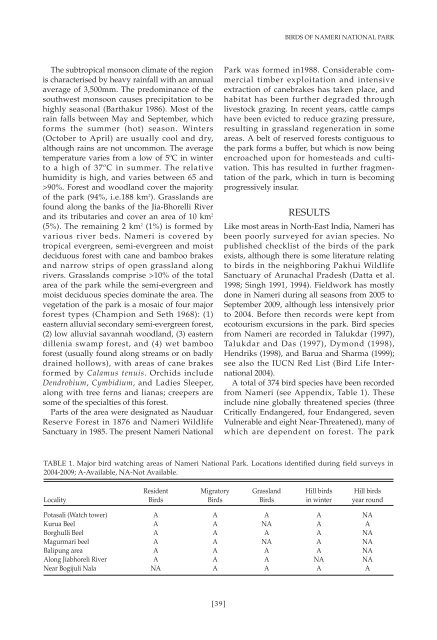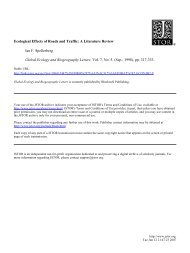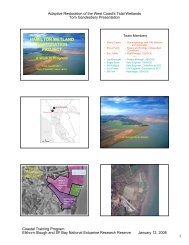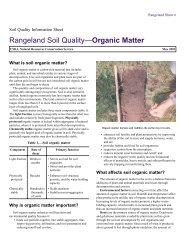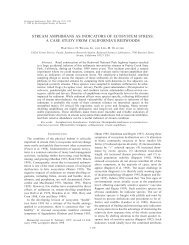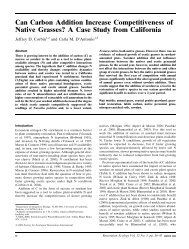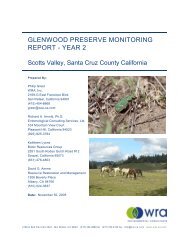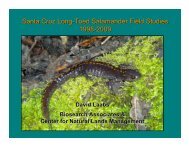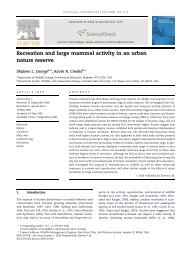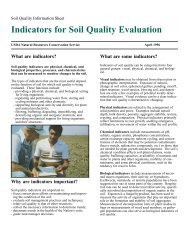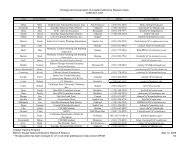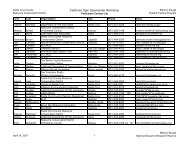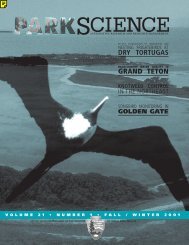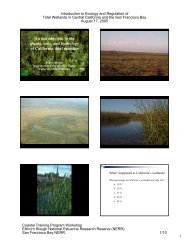NIRANJAN DAS AND SUJATA DEORIincluye, como se reporta en la Lista Roja de la UICN: ocho especies globalmenteamenazadas (Cairina scutulata, Aceros nipalensis, Haliaeetus leucoryphus, Gypsbengalensis, Gyps tenuirostris, Aquila clanga, Leptotilos dubius y Chrysomma altirostre); ycinco especies casi amenazadas (Arborophila atrogularis, Sterna acuticauda, Haliaeetusalbicilla, Ichthyophaga humilis, y Sarcogyps calvus). Las anotaciones resaltan el estadoactual de las especies de aves del Parque Nacional Nameri.Palabras clave: Assam, hotspots de aves, India, Parque Nacional Nameri.INTRODUCTIONNameri National Park (latitude 26º51’ to 27º04’N, longitude 92º39’ to 92º59’ E) covers 200 km 2 ofthe eastern Himalayan foothills in Assam (Fig.1). It is contiguous with Pakhui WildlifeSanctuary in Arunachal Pradesh to the north.Together they exceed 1,000 km 2 , ranging inaltitude from 79 to >1,500m. The park extendseast and south of the west bank of the Bor-Dikorai River from the interstate boundary atSijussa to the left bank of Jia-Bhorelli River alongthe north of Sikam Basti, up to the south bank ofBalipara Reserve Forest. The area is criss-crossedby the Jia-Bhorelli River and its tributariesnamely Diji, Dinai, Doigurung, Nameri, Dikorai,Khari.The terrain is undulating, with lower areas at80–100 m along the Jia-Bhorelli and its tributaries,and higher areas at 200–225m in the central andnorthern parts of the park. Soils are composed ofsand or sandy loam alluvial deposits. Numeroussmall rivers and perennial streams originating inArunachal Pradesh run through the park andfeed into the Jia-Bhorelli River. Many rivers shifttheir course during the rainy season and formdry riverbeds during winter.FIGURE 1. Location of Nameri National Park and distribution of habitats.[38]
<strong>BIRD</strong>S OF NAMERI NATIONAL PARKThe subtropical monsoon climate of the regionis characterised by heavy rainfall with an annualaverage of 3,500mm. The predominance of thesouthwest monsoon causes precipitation to behighly seasonal (Barthakur 1986). Most of therain falls between May and September, whichforms the summer (hot) season. Winters(October to April) are usually cool and dry,although rains are not uncommon. The averagetemperature varies from a low of 5ºC in winterto a high of 37ºC in summer. The relativehumidity is high, and varies between 65 and>90%. Forest and woodland cover the majorityof the park (94%, i.e.188 km 2 ). Grasslands arefound along the banks of the Jia-Bhorelli Riverand its tributaries and cover an area of 10 km 2(5%). The remaining 2 km 2 (1%) is formed byvarious river beds. Nameri is covered bytropical evergreen, semi-evergreen and moistdeciduous forest with cane and bamboo brakesand narrow strips of open grassland alongrivers. Grasslands comprise >10% of the totalarea of the park while the semi-evergreen andmoist deciduous species dominate the area. Thevegetation of the park is a mosaic of four majorforest types (Champion and Seth 1968): (1)eastern alluvial secondary semi-evergreen forest,(2) low alluvial savannah woodland, (3) easterndillenia swamp forest, and (4) wet bambooforest (usually found along streams or on badlydrained hollows), with areas of cane brakesformed by Calamus tenuis. Orchids includeDendrobium, Cymbidium, and Ladies Sleeper,along with tree ferns and lianas; creepers aresome of the specialties of this forest.Parts of the area were designated as NauduarReserve Forest in 1876 and Nameri WildlifeSanctuary in 1985. The present Nameri NationalPark was formed in1988. Considerable commercialtimber exploitation and intensiveextraction of canebrakes has taken place, andhabitat has been further degraded throughlivestock grazing. In recent years, cattle campshave been evicted to reduce grazing pressure,resulting in grassland regeneration in someareas. A belt of reserved forests contiguous tothe park forms a buffer, but which is now beingencroached upon for homesteads and cultivation.This has resulted in further fragmentationof the park, which in turn is becomingprogressively insular.RESULTSLike most areas in North-East India, Nameri hasbeen poorly surveyed for avian species. Nopublished checklist of the birds of the parkexists, although there is some literature relatingto birds in the neighboring Pakhui WildlifeSanctuary of Arunachal Pradesh (Datta et al.1998; Singh 1991, 1994). Fieldwork has mostlydone in Nameri during all seasons from 2005 toSeptember 2009, although less intensively priorto 2004. Before then records were kept fromecotourism excursions in the park. Bird speciesfrom Nameri are recorded in Talukdar (1997),Talukdar and Das (1997), Dymond (1998),Hendriks (1998), and Barua and Sharma (1999);see also the IUCN Red List (Bird Life International2004).A total of 374 bird species have been recordedfrom Nameri (see Appendix, Table 1). Theseinclude nine globally threatened species (threeCritically Endangered, four Endangered, sevenVulnerable and eight Near-Threatened), many ofwhich are dependent on forest. The parkTABLE 1. Major bird watching areas of Nameri National Park. Locations identified during field surveys in2004-2009; A-Available, NA-Not Available.Resident Migratory Grassland Hill birds Hill birdsLocality Birds Birds Birds in winter year roundPotasali (Watch tower) A A A A NAKurua Beel A A NA A AB<strong>org</strong>hulli Beel A A A A NAMagurmari beel A A NA A NABalipung area A A A A NAAlong Jiabhoreli River A A A NA NANear Bogijuli Nala NA A A A A[39]
- Page 1 and 2: BIRD POPULATIONSA journal of global
- Page 3 and 4: BIRD POPULATIONSA journal of global
- Page 6 and 7: ROBERT L. WILKERSON AND RODNEY B. S
- Page 8 and 9: ROBERT L. WILKERSON AND RODNEY B. S
- Page 10 and 11: ROBERT L. WILKERSON AND RODNEY B. S
- Page 12 and 13: ROBERT L. WILKERSON AND RODNEY B. S
- Page 14 and 15: ROBERT L. WILKERSON AND RODNEY B. S
- Page 16 and 17: ROBERT L. WILKERSON AND RODNEY B. S
- Page 18 and 19: ROBERT L. WILKERSON AND RODNEY B. S
- Page 20 and 21: ROBERT L. WILKERSON AND RODNEY B. S
- Page 22 and 23: ROBERT L. WILKERSON AND RODNEY B. S
- Page 24 and 25: ROBERT L. WILKERSON AND RODNEY B. S
- Page 26 and 27: ROBERT L. WILKERSON AND RODNEY B. S
- Page 28 and 29: ROBERT L. WILKERSON AND RODNEY B. S
- Page 30 and 31: ROBERT L. WILKERSON AND RODNEY B. S
- Page 32 and 33: ROBERT L. WILKERSON AND RODNEY B. S
- Page 34 and 35: ROBERT L. WILKERSON AND RODNEY B. S
- Page 36 and 37: ROBERT L. WILKERSON AND RODNEY B. S
- Page 38 and 39: ROBERT L. WILKERSON AND RODNEY B. S
- Page 42 and 43: NIRANJAN DAS AND SUJATA DEORIprovid
- Page 44 and 45: NIRANJAN DAS AND SUJATA DEORIpopula
- Page 46 and 47: NIRANJAN DAS AND SUJATA DEORITABLE
- Page 48 and 49: NIRANJAN DAS AND SUJATA DEORITABLE
- Page 50 and 51: NIRANJAN DAS AND SUJATA DEORITABLE
- Page 52 and 53: NIRANJAN DAS AND SUJATA DEORITABLE
- Page 54 and 55: NIRANJAN DAS AND SUJATA DEORITABLE
- Page 56 and 57: NIRANJAN DAS AND SUJATA DEORITABLE
- Page 58 and 59: Bird Populations 10:56-64© The Ins
- Page 60 and 61: WETLAND BIRDS OF GHANAAvicennia afr
- Page 62 and 63: WETLAND BIRDS OF GHANATABLE 1. Data
- Page 64 and 65: WETLAND BIRDS OF GHANATABLE 2: Esti
- Page 66 and 67: WETLAND BIRDS OF GHANAATTUQUAYEFIO,
- Page 68 and 69: JANNIK HANSEN, LARS HOLST HANSEN, N
- Page 70 and 71: JANNIK HANSEN, LARS HOLST HANSEN, N
- Page 72 and 73: JANNIK HANSEN, LARS HOLST HANSEN, N
- Page 74 and 75: JANNIK HANSEN, LARS HOLST HANSEN, N
- Page 76 and 77: JANNIK HANSEN, LARS HOLST HANSEN, N
- Page 78 and 79: JANNIK HANSEN, LARS HOLST HANSEN, N
- Page 80 and 81: JANNIK HANSEN, LARS HOLST HANSEN, N
- Page 82 and 83: JANNIK HANSEN, LARS HOLST HANSEN, N
- Page 84 and 85: JANNIK HANSEN, LARS HOLST HANSEN, N
- Page 86 and 87: JANNIK HANSEN, LARS HOLST HANSEN, N
- Page 88 and 89: JANNIK HANSEN, LARS HOLST HANSEN, N
- Page 90 and 91:
BIRD POPULATIONSA journal of global
- Page 92 and 93:
Bird Populations 10:90-109© The In
- Page 94 and 95:
DAVID J. ZIOLKOWSKI JR., KEITH L. P
- Page 96 and 97:
DAVID J. ZIOLKOWSKI JR., KEITH L. P
- Page 98 and 99:
DAVID J. ZIOLKOWSKI JR., KEITH L. P
- Page 100 and 101:
DAVID J. ZIOLKOWSKI JR., KEITH L. P
- Page 102 and 103:
DAVID J. ZIOLKOWSKI JR., KEITH L. P
- Page 104 and 105:
DAVID J. ZIOLKOWSKI JR., KEITH L. P
- Page 106 and 107:
DAVID J. ZIOLKOWSKI JR., KEITH L. P
- Page 108 and 109:
DAVID J. ZIOLKOWSKI JR., KEITH L. P
- Page 110 and 111:
DAVID J. ZIOLKOWSKI JR., KEITH L. P
- Page 112 and 113:
Bird Populations 10:110-113© The I
- Page 114 and 115:
THE 2007 AND 2008 NORTH AMERICAN BR
- Page 116 and 117:
Bird Populations 10:114-124© The I
- Page 118 and 119:
BREEDING BIRD CENSUS: 2007on the pl
- Page 120 and 121:
BREEDING BIRD CENSUS: 2007May, with
- Page 122 and 123:
BREEDING BIRD CENSUS: 2007Remarks:
- Page 124 and 125:
BREEDING BIRD CENSUS: 200717. PITCH
- Page 126 and 127:
BREEDING BIRD CENSUS: 2007+; Wester
- Page 128 and 129:
BREEDING BIRD CENSUS: 2008gray Gnat
- Page 130 and 131:
BREEDING BIRD CENSUS: 2008Warbler,
- Page 132 and 133:
BREEDING BIRD CENSUS: 2008Source: W
- Page 134 and 135:
BREEDING BIRD CENSUS: 2008Spotted T
- Page 136 and 137:
BREEDING BIRD CENSUS: 2008precipita
- Page 138 and 139:
Bird Populations 10© The Institute
- Page 140 and 141:
IS AVIAN BREEDING SUCCESS WEATHERIN
- Page 142 and 143:
IS AVIAN BREEDING SUCCESS WEATHERIN
- Page 144 and 145:
DAVE LEECH AND CARL BARIMOREFlycatc
- Page 146 and 147:
Bird Populations 10:143-145Reprinte
- Page 148 and 149:
WOODPIGEON JOINS THE GARDEN PREMIER
- Page 150 and 151:
CHANGING THE GUARD AT UK BIRDTABLES
- Page 152 and 153:
Bird Populations is an entirely ele
- Page 154:
BIRD POPULATIONSA journal of global


